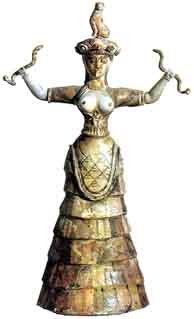Women in the Aegean
Minoan Snake Goddess
Christopher L. C. E. Witcombe
8. Snakes, Egypt, Magic & Women
Following his discussion of the snake as a household deity, Evans comments on the similarity in the position of the snake raising its head above the hat of the principal "Snake Goddess" (Evans here ignoring the fact that this particular detail of the figurine is his own reconstruction - see Evans's "Snake Goddess") and that of the Egyptian uraeus (rearing cobra snake) on the head of Hathor and other Egyptian goddesses. In particular, Evans tentatively links the "Snake Goddess" with the Egyptian Goddess Wazet (i.e. Wadjyt), the snake goddess of the Nile Delta, but does not pursue the connection.
It is clear that the Minoans borrowed much their culture and various cult practices from Egypt. Numerous Egyptian objects of one kind or another were found by Evans at Knossos. The most spectacular discovery was the lower part of diorite statue of a seated Egyptian figure identified from the hieroglyphic inscriptions as a priest of Wadjyt (or Wadjet; written as Wazet by Evans; and as Uatchet, or Uatchit, by Budge [see Budge in the BIBLIOGRAPHY]).
As was noted above, sacred to Wadjyt was the cobra snake which in the form of the uraeus became the distinctive emblem of the Kingdom of Lower Egypt and the Egyptian royal house. Wadjyt was principally the snake goddess of Buto, or Pe, her ancient sanctuary in the Nile Delta. She was also associated with the city known to the Greeks as Aphroditopolis (the city of Aphrodite; the signs of the nome of Aphroditopolis were a snake and a feather), with whom Wadjyt was identified. Like Aphrodite, Wadjyt was a goddess of fertility. Later, she was assimilated with Isis.
In her snake form, Wadjyt is sometimes identified as Weret-hekau, "Great of Magic", who, as the uraeus, a manifestation of the solar eye, rises from the forehead of Horus (the pharaoh). As the uraeus, Wadjyt and Weret-hekau were identified with the eye of Re. The Goddesses Tefnut and Bastet were also identified with the eye of Re. As both were commonly shown lioness-headed, so Wadjyt and Weret-hekau were also sometimes represented with lioness-heads. This has sometimes caused all these goddesses to be identified with the lioness goddess Sekhmet.
Originally simply an epithet applied to goddesses, crowns, and uraeus, Weret-hekau was also a goddess in her own right. Her principal tasks were to protect the creator sun god and to act as foster-mother to the pharaohs. Weret-hekau's name, together with snake decoration and solar eyes, occasionally appears on magical implements such as model throwsticks (used by the deceased to defend themselves against malevolent spirits and demons), and apotropaic wands (or 'magic knives') made of ivory which seem to have been used to protect women, especially pregnant or nursing women, and women with children. Among the papyri found in a cache of magical objects in a tomb under the Ramesseum (see below) is one devoted to spells for women and children.
Magic was a beneficial force in Egypt and was used widely in all periods. The earliest attested magical texts are in the Pyramid Texts composed late in Dynasty V and Dynasty VI in the Old Kingdom. The god of magic, Heka (heka is also the Egyptian word for 'magic'), to whom shrines were dedicated in Lower Egypt, was depicted in human form (sometimes with a snake head) holding a snake-shaped wand in each hand. The snake wand, which was also used by magicians, probably represented Weret-hekau.

Wooden statuette of a woman holding metal snakes
Dynasty XIII (1786-1633 BCE)
(The Manchester Museum, University of Manchester, England)
The combination of snake wands and the lioness head is seen in a wooden statuette of woman with movable arms found in 1896 by James Edward Quibell in a cache of magical objects in a tomb dating to Dynasty XIII (1786-1633 BCE) discovered under the Ramesseum, the mortuary temple of Ramesses II (1290-1224 BCE), at Thebes. The statuette, which holds a metal snake-wand in each hand, is thought to represent a female sau, a type of magician, who could supply magical protection (the Egyptian verb sa means "to protect") both by making charms and amulets, and by using spoken and written charms.
Besides the statuette, the cache also included some magico-medical papyri and a twisting bronze snake wand (now in the Fitzwilliam Museum, Cambridge) which was evidently intended to be held in the middle where its body flattens out. It is approximately twice the size of those held by the wooden figurine. Possibly the Minoan votary is also holding snake-wands.
The sau statuette is usually described as representing either the beneficent lion-demon later known as Bes (a god often called upon to protect women in childbirth and their infants), or a woman playing the role of the demon in a magical rite. However, the combination of lioness mask and snakes also suggests that she might be representing or serving in some way, perhaps as a votary or a priestess, the goddess Wadjyt. Her nudity may indicate a connection with fertility figurines (a group of which were found in the same cache), or that she is a religious dancer who helped in the protective rites.
An interesting feature of the Egyptian statuette is its moveable arms which could be raised so that the metal snakes in each hand are held up in a manner reminiscent of the Minoan Snake Goddess.
9. SNAKE CHARMERS 
|

Minoan Snake Goddess
from Knossos, Crete
c. 1600 BCE
faïence
height 131/2 inches (34.3 cm)
(Archeological Museum, Herakleion)
Copyright © (text only) 2000
Christopher L. C. E. Witcombe
All rights reserved
|

